Urban Resilience: Reporters’ Notebooks
This month fellows of the UBC School of Journalism International Reporting Program are traveling throughout China, Colombia, and India, to investigate the human cost that rapid urbanization has had – and will continue to have if current trends persist – across the globe. Many urban areas are not prepared for the inevitable influx, which can put pressure on every aspect of city life, including: sanitation, housing, sewage, public health, transportation, education and political governance. Below are daily notebooks from reporters in the field.
Bangalore, 2016
Emilie Rauschuetz
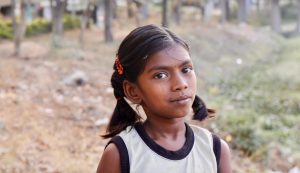 Lakshmi will stay in my mind for quite some while. Lakshmi is 9 years old and lives in a small informal settlement, squished between apartment buildings, in Bangalore, India. She has no access to electricity, no access to running water and sleeps on a stone floor. Yet, Lakshmi is the kindest and also smartest 9-year-old I’ve encountered in my life. Not smart because she reads books or solves math problems, smart because she can take care of herself and navigate a city of 10 million people. Her fragile, skinny body holds a strong, independent, young soul in it. She took us to a dried up lake, that used to be adjacent to their settlement. As we’re walking to this lake, Lakshmi holds her head high. Her body is relaxed. She barely reacts to the honking and the traffic. While I, at 23 years old, 170cm tall, am still terrified of crossing the street in Bangalore, little Lakshmi just strides across the 6 lanes of cars, trucks, auto rickshaws and trucks soaring by. Akshatha, my colleague, insists on holding her hand as we cross, but Lakshmi barely tightens her grip. Her fingers are loose; her thoughts are wandering. Lakshmi never saw that lake, but her mom has told her about it many times. We ask her how she feels and she admits: “it must have been nice, to wake up and see a lake.” After taking us back to her shack, we thank her and say goodbye. As a gift, we have brought her a pencil case for school, with pencils and a calculator in it. Lakshmi’s eyes lighten up of joy and she shakes all of our hands, one by one. Her grip is not too tight and not too loose, it is respectful and thankful. We take off and as we’re on our way back to the city center, I revisit what we experienced. I think about our topic and out story: urban resilience. And then it hits me, Lakshmi is urban resilience.
Lakshmi will stay in my mind for quite some while. Lakshmi is 9 years old and lives in a small informal settlement, squished between apartment buildings, in Bangalore, India. She has no access to electricity, no access to running water and sleeps on a stone floor. Yet, Lakshmi is the kindest and also smartest 9-year-old I’ve encountered in my life. Not smart because she reads books or solves math problems, smart because she can take care of herself and navigate a city of 10 million people. Her fragile, skinny body holds a strong, independent, young soul in it. She took us to a dried up lake, that used to be adjacent to their settlement. As we’re walking to this lake, Lakshmi holds her head high. Her body is relaxed. She barely reacts to the honking and the traffic. While I, at 23 years old, 170cm tall, am still terrified of crossing the street in Bangalore, little Lakshmi just strides across the 6 lanes of cars, trucks, auto rickshaws and trucks soaring by. Akshatha, my colleague, insists on holding her hand as we cross, but Lakshmi barely tightens her grip. Her fingers are loose; her thoughts are wandering. Lakshmi never saw that lake, but her mom has told her about it many times. We ask her how she feels and she admits: “it must have been nice, to wake up and see a lake.” After taking us back to her shack, we thank her and say goodbye. As a gift, we have brought her a pencil case for school, with pencils and a calculator in it. Lakshmi’s eyes lighten up of joy and she shakes all of our hands, one by one. Her grip is not too tight and not too loose, it is respectful and thankful. We take off and as we’re on our way back to the city center, I revisit what we experienced. I think about our topic and out story: urban resilience. And then it hits me, Lakshmi is urban resilience.

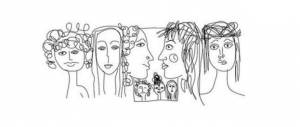
Bangalore, 2016
Joseph Rohit
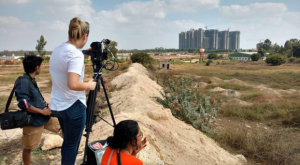 Day 2
Day 2
High rise residential buildings encroach on Bangalore’s farmland. I last visited in 2009 and since then, the landscape has completely changed with malls, apartments and developments everywhere. Urbanization in action.

Day 4
A sea of tomatoes at Kolar Market. After our interview with Sunil Kumar, a farmer who grows food a few kilometers outside of Bangalore, we decided to take a look around. Kolar Market is Asia’s second largest tomato market. Tomatoes are a popular crop in India. The coast is relatively low and they are quite easy to grow. However, an oversaturation of tomatoes in the market has made it a struggle for farmers to make enough money. Combine that with the Indian government’s demonetization plan and the price has plummeted to a new low (just a few cents per kilogram) Consumers are benefiting while producers struggle.
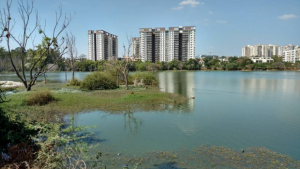
Days 5 and 8
Kaikondrahalli Lake is an urban oasis outside Bangalore. The lakes around the city help cool the temperature, absorb greenhouse gasses, bolster biodiversity and provide a much-needed escape from the city. These lakes and green spaces are threatened by large scale high rise developments. Water is becoming scarce. Thanks to a partnership between community volunteers led by Harini Nagendra and Priya Ramasubban, Kaikondrahalli is one of the few lakes to be rejuvenated. This beautiful image masks a nearby slum or informal settlement, where temporary workers from the villages settle and try to make a living.

The crew and interacting with the kids in the community. We talked to parents who said that it was impossible to convince their children to go to school. The children find city schools intimidating, so they prefer to stay close to their village lives.
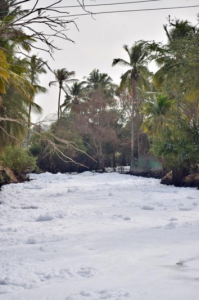
Day 9
The white frothy substance you see is not snow in Bangalore. This is the result of industrial waste and untreated sewage seeping into some of the city’s most prominent lakes (Bellandur pictured above). These chemicals produce a pungent foam. The water from these lakes is used to irrigate the fields of urban villages. Critics say the result is increasing crop failure and chronic health issues for farmers. Just two decades ago, these lakes provided drinking water for residents.
Tianjin, 2016
John Woodside
The past 30 hours have been a whirlwind. We traveled from Tianjin to Changsha to Yongzhou to Shuangpai county to Daguping village. We were off in search of an “important” interview. The mother of a young firefighter who died during the Tianjin Explosion. The father was going to show us a memorial he built to honour their son. They agreed to an interview over the phone late on Wednesday, we booked tickets Thursday, and arrived late Friday night. But as soon as we met we sensed a problem. The mother seemed skeptical. The father seemed more willing to talk. We tried over dinner to create a connection.
We agreed to meet the next morning. We got up early to drive to the village. The father was there and ready. We set up our camera, got the framing and lighting just right, hooked up our microphones and began rolling. I was relieved.
And then, two minutes later, the mother stormed in. We had to stop. She was afraid. Fearful that speaking to a foreigner would put herself and her children at risk.
We negotiated, we pleaded, we tried everything, but she refused. We packed up our gear. We learned a valuable lesson about the limits of our ability to tell stories if our subjects no longer feel safe to share. We always wanted to be respectful with or without a rolling camera.
The father walked us to the memorial and he spoke about its significance to him and this community. He told us we could take a few photographs. Then he walked away and we were left standing there in this place of memory.

Beijing, 2016
Peggy Lam
It’s 7:32pm in Beijing. I’m on my way back from our shoot.
This experience has been surreal. I’ve learned so much being here. For one, I realize we take our freedom of expression and freedom of the press for granted.
China has a completely different media climate. I knew that. But witnessing it is another story. There is a legitimate fear and anxiety when it comes to speaking to media, especially with foreign journalists. The people we talk to remind us all the time.
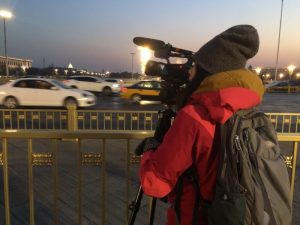 It’s been such a privilege to be here. As a student. As a journalist. As a Westerner.
It’s been such a privilege to be here. As a student. As a journalist. As a Westerner.
We’ve been lucky to be working with two journalism students from Nanjing University. They’ve taught me the meaning of hard work and perseverance. 15 hour days and no complaints.
I look somewhat Chinese, so I can pass for a local. I can’t speak a word of Mandarin or Cantonese. I have Chinese ancestry – half of my family is from Fujian, but I know nothing about this country. My appearance has allowed me access to some of the most intimate spaces on this trip. I can go to spaces where “foreigners” aren’t allowed to visit or film. A migrant teacher’s home in the outskirts of Beijing. Neighborhoods where there’s high surveillance executed by the local government. Into the homes of parents suing the municipal government. All of these places are usually off limits.
Yet, we got in. We were lucky to do so. And none of it would have been possible without the people in our stories. They are the ones taking risks for our work.
I don’t know if we can do this story justice. It comes with a lot of weight. But we are going to try our best.
And tonight, we’re celebrating this adventure, with Peking duck.
Cali, 2016
Stefan Labbe
One night in Cali…
The police call it “plan life”, a nightly ritual where officers systematically flood shantytown alleys to round up and beat people loitering in the street.
The police strip people of any weapons then toss them into the back of a truck which looks like it belongs on a cattle ranch rather than the streets of Cali, Colombia’s third-largest city.
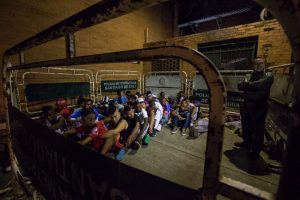 “Four to five people die a night here,” said officer Jonatan Vanegas. He’s talking to us from the back of a police pickup truck. We’ve just been chased out of an alley with flying bricks and bottles.
“Four to five people die a night here,” said officer Jonatan Vanegas. He’s talking to us from the back of a police pickup truck. We’ve just been chased out of an alley with flying bricks and bottles.
When Vanegas and his team get back to the station they herd everyone into a cordoned off pen. That’s where they sit, lined up, heads down for the next three hours.
Outside of the station, a crowd slowly gathers. These are the sisters, aunts, and mothers of the mostly male captives held inside.
“It’s unjust,” one mother tells me as she wipes away a tear. “When they get out they have to cross all these invisible gang borders. First they are assaulted by the police, and then they’re attacked by other gangs on their way home.”
Vanegas and his team do not apologize. They say it’s the only way to keep people safe from killing each other.